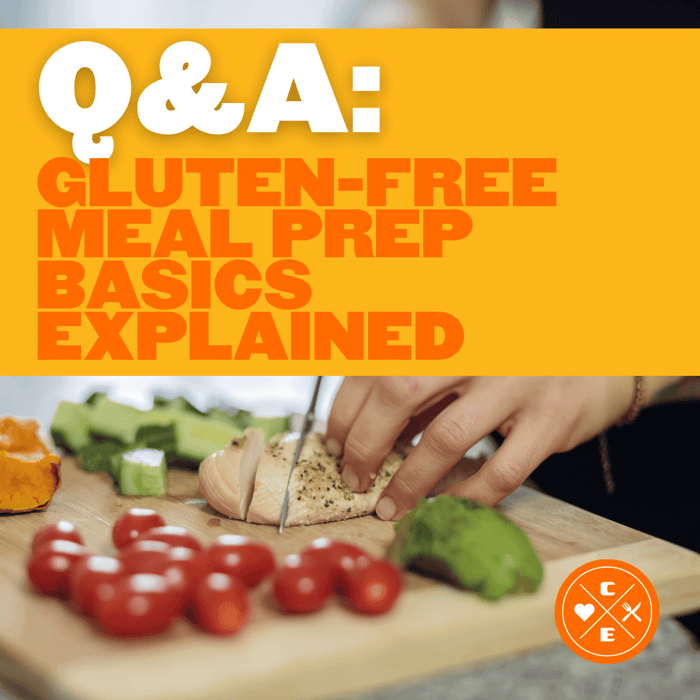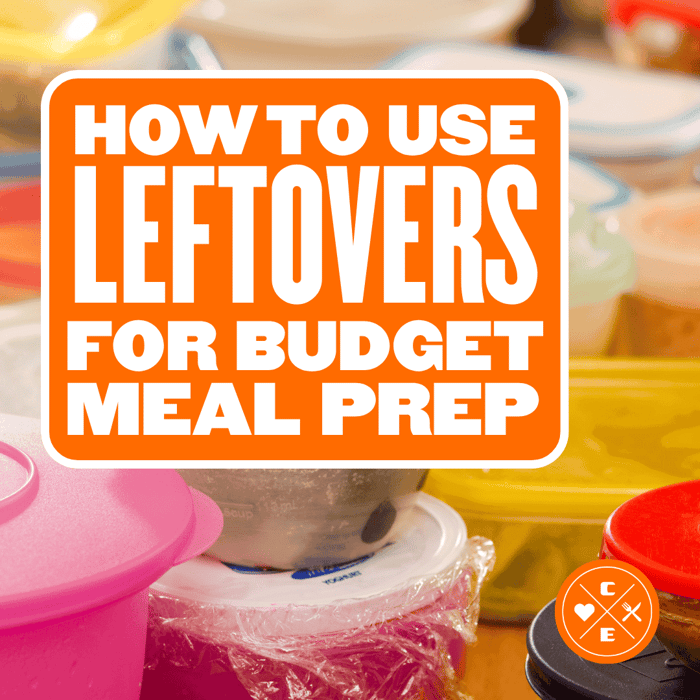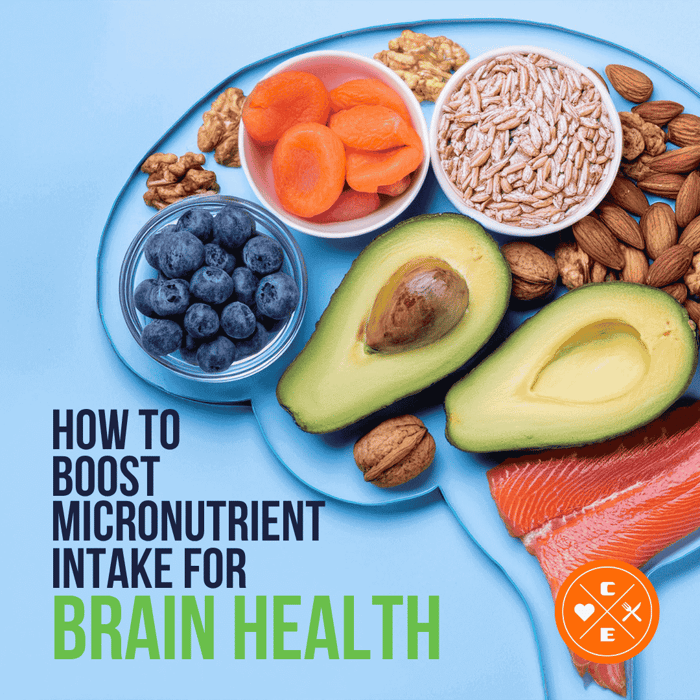Q&A: Gluten-Free Meal Prep Basics Explained

Jason Nista
Nutrition
06/17/2025 12:36pm
17 minute read
Table of Contents
If you're navigating a gluten-free lifestyle, meal prep can save time, reduce stress, and help you avoid gluten contamination. Here's what you need to know:
- What is Gluten-Free Meal Prep? It’s about planning and cooking meals without gluten (found in wheat, barley, and rye) using safe, naturally gluten-free ingredients like rice, quinoa, fresh veggies, and lean proteins.
- Why It Matters: For those with celiac disease or gluten intolerance, even tiny amounts of gluten can cause health issues. Meal prep ensures control over ingredients and prevents accidental exposure.
- Key Ingredients: Stock up on gluten-free staples like quinoa, rice, almond flour, tamari (soy sauce alternative), and fresh produce.
- Simple Swaps: Replace wheat flour with options like rice or chickpea flour, and use tamari or coconut aminos instead of soy sauce.
- Meal Prep Tips: Plan meals around pantry staples, batch cook grains and proteins, and store meals in airtight containers to prevent contamination.
- Storage & Reheating: Use labeled containers, store gluten-free items separately, and reheat safely using ovens, microwaves, or air fryers.
Gluten-free meal prep doesn’t have to be complicated. By focusing on naturally gluten-free foods, organizing your kitchen, and planning ahead, you can enjoy safe, delicious meals all week long.
Gluten-Free Ingredients and Substitutions
Basic Gluten-Free Ingredients
Building a gluten-free pantry starts with a collection of safe grains, flours, and everyday staples. Rice and quinoa are excellent base ingredients, with quinoa standing out for holding its texture better than rice, as noted by Prep Dish.
For baking, almond flour and rice flour are great options, while buckwheat and certified gluten-free oats can add variety. When it comes to cooking, keep legumes like lentils and chickpeas on hand, along with tapioca and arrowroot starches for thickening. Gluten-free pasta options, such as those made from rice or lentils, are also essential. Gina Matsoukas from Running to the Kitchen shares her experience:
"Gluten-free pasta alternatives are a must in our household. I'm partial to brown rice pasta or the newer lentil and vegetable blends. They've come such a long way from corn and rice only options of previous years and make quick and easy dinners a breeze."
Don’t overlook pantry staples like tamari sauce (a gluten-free alternative to soy sauce), gluten-free chicken stock for soups and stews, and a variety of herbs and spices to keep your meals flavorful. For snacks, stock up on nuts, seeds, popcorn, and gluten-free crackers to keep hunger at bay.
Simple Swaps for Gluten-Containing Ingredients
Switching out gluten-containing ingredients can be straightforward if you focus on their function. For wheat flour, try substitutes like rice flour, garbanzo bean flour, potato starch, or tapioca flour. Blending different gluten-free flours often yields better results. Start with simple recipes like flatbreads, biscuits, muffins, or pancakes to test how various flours work together before tackling more advanced baking projects.
For soy sauce, tamari is a fantastic alternative that delivers a similar flavor without the wheat. SAN-J, a well-known tamari producer, describes their process:
"At SAN-J, we brew our Tamari Soy Sauce from soybeans and no wheat to provide a rich, authentic taste."
Coconut aminos offer another gluten-free option, though it’s slightly thinner and sweeter than traditional soy sauce. For a smoky alternative, Bragg Liquid Aminos is a good choice, but keep in mind its higher sodium content. Always check product labels for gluten-free certification to avoid cross-contamination risks.
In addition to ingredient swaps, incorporating fresh, whole foods into your meals can enhance both safety and flavor.
Using Fresh, Naturally Gluten-Free Foods
To round out your gluten-free pantry, fresh whole foods are a must. They eliminate the need for label-checking and are naturally safe. Rinse fruits like berries, apples, and citrus for quick, portable snacks.
Combine fresh produce like mini cucumbers, carrot sticks, and bell peppers with lean proteins such as chicken, fish, eggs, or turkey to create balanced meals. For example, you could prepare quinoa bowls topped with roasted vegetables. Roast a mix of broccoli, carrots, and bell peppers at the start of the week and store them separately from cooked quinoa. When it’s time to eat, simply combine the vegetables with toppings like fried eggs or avocado for a wholesome, satisfying dish.
Meal Prepping 5 Days of Gluten-Free Food
Simple Gluten-Free Meal Prep Strategies
Building on your ingredient selection, these tips will help simplify and streamline your gluten-free meal prep routine.
Step-by-Step Gluten-Free Meal Prep Process
The key to efficient gluten-free meal prep is following a clear, organized process.
Start by planning meals around what you already have. Take stock of your pantry and fridge - gluten-free staples like rice, quinoa, and canned beans can serve as the foundation for your weekly menu. This approach not only reduces food waste but also helps you save on grocery bills.
Once your meals are planned, create a detailed shopping list. Organize it by store sections - group fresh produce, pantry staples, proteins, and frozen items together. This saves time at the store and ensures you don’t forget any essentials.
Before you begin cooking, prep your ingredients. Wash, chop, and measure everything ahead of time, including spices. This prep work makes cooking less stressful and speeds up the process. When possible, double your recipes to have leftovers for freezing or for easy next-day lunches.
With your ingredients ready, batch cooking takes your meal prep efficiency to the next level.
Batch Cooking for Easy Meals
Batch cooking is a weekend game-changer for preparing large quantities of gluten-free dishes, like soups, stews, or casseroles, which freeze and reheat beautifully.
Cook grains such as quinoa or brown rice in bulk and portion them out for use throughout the week. These can serve as a base for salads, bowls, or side dishes. Keep proteins thawing in the fridge so you’re always ready for your next cooking session. With batch-cooked staples on hand, you can mix and match to create quick meals like wraps, salads, or soups without starting from scratch every time.
Setting Up Your Pantry and Kitchen
An organized kitchen not only makes meal prep easier but also helps prevent cross-contamination.
Dedicate specific shelves, drawers, or cabinets exclusively to gluten-free items. Storing these items on higher shelves can further reduce the risk of contamination from crumbs or spills. Use airtight containers for gluten-free grains, flours, and other dry goods to keep them fresh and safe.
Invest in separate cooking tools for gluten-free food preparation - think toasters, cutting boards, and utensils. Color-coding these items can make it easier to distinguish them from others in your kitchen.
"One of the first things that I did after my Celiac diagnosis was to designate pantry areas where no gluten is allowed." - My Gluten Free Cucina
Organize your pantry into zones for snacks, baking supplies, and dinner prep ingredients. Keep a running shopping list of pantry essentials posted on your fridge or inside a cabinet to avoid overbuying and ensure you’re always stocked with what you need. Regularly clean surfaces, appliances, and utensils to eliminate any lingering gluten and maintain a safe cooking environment.
sbb-itb-1989a25
Storage and Reheating Tips for Gluten-Free Meals
Once your gluten-free pantry is organized, the next step is ensuring your meals stay fresh and safe. Proper storage and reheating not only maintain the quality of your meals but also help prevent cross-contamination.
How to Store Gluten-Free Meals
Use airtight containers to keep your food fresh and safe from pests. Opt for clear glass or durable plastic containers so you can easily see what's inside. Having a variety of sizes on hand makes it easier to store different portions. For example, an Amazon reviewer, Orneli Yzeiraj, praised PRAKI Airtight Food Storage Containers, saying, "These food storage containers... are thick plastic and look very sturdy... Lids are silicone airtight, so it gives the goods longer shelf life and no bugs or any of that problems."
Label everything. Clearly mark each container with the product name, the date it was opened, and its best-by date. In shared households, add a "gluten-free" label to avoid accidental cross-contamination.
Store strategically to minimize risks. Place gluten-free items on the top shelves of your pantry, fridge, or freezer. This prevents crumbs or spills from gluten-containing foods above from contaminating your meals.
Follow refrigeration and freezing tips for specific gluten-free foods. Many gluten-free products lack preservatives, so they can spoil faster once opened. Refrigerate items like gluten-free bread after opening and use them within 2–3 days. For longer storage, freeze bread after slicing it. Wrap each slice in plastic wrap or freezer-safe bags to protect it from freezer burn.
If you're storing meals for weeks, consider vacuum-sealing them. This method works especially well for batch-cooked proteins or prepared dishes, keeping them fresh and flavorful.
Once your meals are stored safely, reheating them correctly is key to preserving their taste and texture.
How to Reheat Gluten-Free Meals Safely
Proper reheating is just as important as storage. Different methods work better for different types of food, so choose the one that best suits your meal.
Oven reheating is ideal for casseroles, roasted vegetables, or large portions. Preheat your oven to 375°F (190°C), spread the food on a baking sheet, cover it with foil to lock in moisture, and bake for 10–15 minutes. According to the USDA, pre-cooked foods should be reheated to at least 325°F (165°C).
Stovetop reheating helps maintain flavor and texture. Heat a skillet on medium, add a little oil, and cook for 8–10 minutes, stirring occasionally. A splash of water or broth can keep the food moist and prevent sticking.
Microwave reheating is the fastest option. Place your food in a microwave-safe container, cover it with a damp paper towel or lid, and heat in 30–60 second intervals. Stir halfway through to ensure even heating.
Air fryer reheating is perfect for achieving a crispy texture. Preheat to 350°F (175°C), spread the food in a single layer, lightly spray with oil, and cook for 5–8 minutes, shaking the basket halfway.
Boost flavors while reheating by adding a touch of butter, fresh herbs, lemon juice, or seasonings like salt, pepper, or soy sauce to bring back flavors that may have faded during storage.
Keep an eye on temperatures to ensure food safety. Reheat all pre-cooked meals to an internal temperature of 165°F (74°C), and vacuum-sealed foods should reach at least 140°F (60°C). A food thermometer can help ensure accuracy.
Avoid overcooking. Slightly undercook meals during preparation to prevent them from becoming mushy or dry when reheated.
"A very important part of maintaining a gluten-free diet is carefully avoiding gluten as an ingredient in food, drinks and products that enter the mouth. Equally important is to avoid cross-contact of gluten-free foods with gluten-containing foods, as even tiny amounts of gluten can cause symptoms and damage your small intestine." - BIDMC of Boston
In shared kitchens, make sure all reheating equipment is thoroughly cleaned before use. Alternatively, dedicate separate microwave-safe containers and utensils for gluten-free foods. This extra step ensures your meals stay safe and uncontaminated.
Gluten-Free Meal Prep Ideas
Building on proper storage and reheating tips, here are some flavorful gluten-free meal prep suggestions to keep your weekly menu exciting and hassle-free.
Easy Gluten-Free Meal Combinations
The key to simple and satisfying gluten-free meals lies in using naturally gluten-free ingredients and making smart substitutions. For example, pair grilled chicken with quinoa and roasted vegetables for a hearty, customizable dish. Or whip up egg muffins with spinach and cheese for a protein-packed option that’s perfect for busy mornings or quick snacks.
The Hy-Vee Test Kitchen shared some practical gluten-free meal prep ideas in January 2022. Their Chili Lime Chicken Tacos recipe is a standout - just pack the filling and tortillas separately to keep them fresh and prevent sogginess. Another favorite is their Shepherd’s Lentil Pie, a vegetarian option that freezes well in individual portions, making it a convenient choice for single-serving meals.
Breakfast Egg Cups also earned praise for being easy to prepare and versatile enough to customize with a variety of vegetables, meats, and cheeses. These are perfect for weekly meal prep and help avoid flavor fatigue.
For tacos, stick to certified gluten-free corn tortillas, and for an Asian-inspired twist, swap out soy sauce for tamari. Other meal ideas include chicken tray bakes with potatoes and Mediterranean spices, spicy shrimp tacos, and chicken broccoli rice casseroles - dishes that reheat beautifully throughout the week. Add a homemade sauce or dressing to any of these meals to take the flavors to the next level.
Making Homemade Sauces and Dressings
Homemade sauces and dressings are a simple way to elevate your meals while giving you full control over the ingredients. They’re quick to make and ensure there are no hidden additives or gluten.
"Switching to homemade salad dressing is a smart move for gluten-free cooks. They're quick and easy to make, with or without a recipe, and you probably have the ingredients on hand. No label to read, no additives or preservatives. You can't beat that!" - Everyday Gluten Free Gourmet
Start with a basic vinaigrette using the 3:1 ratio - three parts oil (like olive oil) to one part acid (such as lemon juice or vinegar). Add Dijon mustard, salt, and pepper to create a smooth emulsion that won’t separate easily. Store your dressings in mason jars in the fridge for easy access throughout the week.
Experiment with different oils and acids to create unique flavor profiles. Walnut oil with balsamic vinegar works well for earthy salads, while sesame oil with rice vinegar adds an Asian flair. For Mexican-inspired bowls, try avocado oil with fresh lime juice.
When making thicker sauces, use gluten-free alternatives like cornstarch, rice flour, or tapioca starch instead of wheat flour. For roux-based sauces, whisk in your stock gradually to avoid lumps. Other techniques like pureeing, reducing, or emulsifying can also create rich, gluten-free sauces.
If you’re also following a keto diet, xanthan gum or guar gum can replace traditional thickeners. Use these sparingly - a little goes a long way.
While some store-bought sauces are now gluten-free certified, such as Heinz ketchup and Sarson’s Malt Vinegar (as of October 2024), making your own ensures more control over taste and ingredients.
Ready-to-Eat Gluten-Free Meal Options
For those times when life gets hectic, professionally prepared gluten-free meals can be a lifesaver. Clean Eatz Kitchen offers a gluten-free meal delivery service where you can customize your plan with meals that don’t contain gluten as an allergen. These single-serve, frozen meals cost $8.99 each and rely on supplier data for gluten-free categorization.
The convenience is unbeatable - meals last up to 12 months in the freezer and ship nationwide via UPS. Plus, orders over $85 qualify for free shipping, making it easy to stock up without any subscription commitments. These meals are microwave-ready, perfect for weeks when you’re short on time or energy.
Clean Eatz Kitchen addresses common challenges in gluten-free meal prep, such as time constraints and cross-contamination risks. Their chef-prepared, portion-controlled meals eliminate guesswork around storage and ensure safe preparation. They even offer meal combinations tailored to specific dietary goals, like High Protein and Gluten-Free or Keto and Gluten-Free options.
Keeping a backup supply of these ready-to-eat meals can be a game-changer. Whether you’re traveling, dealing with unexpected schedule changes, or just need a break from cooking, you’ll always have a reliable, tasty option that fits your dietary needs.
Conclusion
Preparing gluten-free meals doesn't have to feel overwhelming. The key is to focus on naturally gluten-free, wholesome foods. Think fresh vegetables, fruits, lean proteins, and certified gluten-free grains as the cornerstone of your meals. As Rachel Begun, M.S., RDN, a culinary nutritionist and expert in gluten-free diets, advises:
"Fill up your plate with naturally wholesome gluten-free foods, such as vegetables, fruits, beans, nuts, seeds, fish and lean meat."
Beyond sticking to the basics, paying close attention to product labels is crucial. Gluten can hide in unexpected places like condiments, broths, or deli meats, so reading labels carefully helps you avoid unwanted surprises. Planning meals and snacks ahead of time also reduces the temptation to rely on processed gluten-free products, which often lack the nutritional benefits of whole foods.
Effective meal prep not only saves time but also minimizes the risk of cross-contamination. By prioritizing fresh, whole ingredients over processed alternatives, you can enjoy meals that are both nutritious and flavorful throughout the week.
For those moments when life gets busy, convenience options can be a lifesaver. Clean Eatz Kitchen offers chef-prepared, portion-controlled gluten-free meals delivered straight to your door. These ready-made meals provide a hassle-free way to stay on track without sacrificing nutrition or taste.
With an estimated one in 133 Americans living with celiac disease, you're far from alone in navigating a gluten-free lifestyle. Whether you're managing celiac disease or gluten sensitivity, the techniques we've covered - choosing smart ingredients, planning meals effectively, and having reliable backup options - can help you maintain a fulfilling and stress-free gluten-free routine.
FAQs
What are some tips to avoid cross-contamination when preparing gluten-free meals in a shared kitchen?
To keep a shared kitchen safe from cross-contamination, a few precautions can make all the difference. Start by storing gluten-free foods separately from anything containing gluten. Use dedicated utensils, cutting boards, and cookware exclusively for gluten-free cooking, and consider labeling them to avoid mix-ups.
Before cooking, take the time to thoroughly clean all surfaces, including countertops, stovetops, and shared appliances. Always prepare gluten-free meals first to reduce the chance of residue transferring. Be mindful of shared items like butter, condiments, or spreads - these can easily pick up crumbs and should be kept separate for gluten-free use.
By sticking to these practices, you can help ensure your gluten-free meals stay safe and uncontaminated.
What are some quick and easy gluten-free meal prep ideas for beginners?
If you're just starting with gluten-free meal prep and find yourself pressed for time, focus on simple, versatile staples. Ingredients like sweet potatoes, quinoa, brown rice, and potatoes are great options. They can be cooked ahead of time and used as the base for countless meals. Pair these with pre-cooked proteins such as grilled chicken or tofu, along with fresh or steamed vegetables, to create well-rounded, gluten-free dishes.
For quick and tasty meals, consider options like gluten-free chicken tenders, chili lime chicken tacos, or a speedy veggie stir-fry. Many of these dishes can be whipped up in 20 minutes or less, making them ideal for packed schedules. To save even more time during the week, prep ingredients like chopped vegetables or cooked grains in advance. With just a bit of planning, you can enjoy delicious, gluten-free meals without the hassle!
How can I tell if a product is truly gluten-free and safe for someone with celiac disease?
To confirm that a product is gluten-free and safe for someone with celiac disease, look for official certifications like the GFCO (Gluten-Free Certification Organization) mark. This certification indicates the product has been tested and contains less than 10 parts per million (ppm) of gluten. Also, check the packaging for a clear "gluten-free" label and carefully review the ingredient list to ensure it doesn’t include hidden sources of gluten.
For extra reassurance, consider buying from well-known brands or reliable companies that focus on gluten-free products. Third-party certifications provide an additional layer of security, which is especially important for those with severe gluten sensitivities or celiac disease.
Related Articles
How To Use Leftovers For Budget Meal Prep
18 minute read
Carb Loading for Multi-Day Stage Races
15 minute read
How to Boost Micronutrient Intake for Brain Health
16 minute read



